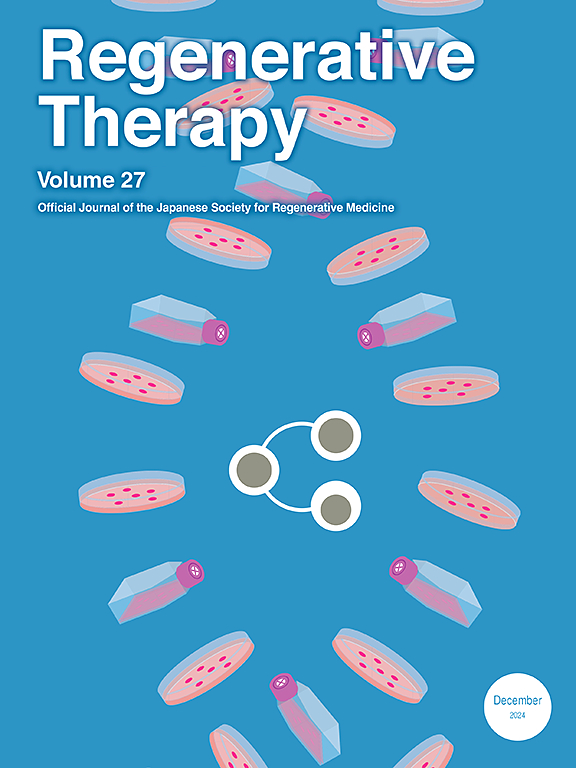来源于人多能干细胞的生物3d打印无支架软骨构建物移植到免疫缺陷猪的关节软骨再生
IF 3.5
3区 环境科学与生态学
Q3 CELL & TISSUE ENGINEERING
引用次数: 0
摘要
关节成形术是目前重建大型关节软骨缺损的唯一选择,主要是由于骨关节炎。然而,人工材料的重建有几个问题,如恶化,异物反应,细菌感染。本研究建立了一种关节软骨重建的新方法,通过制造无支架软骨构建体,在无人工材料的情况下将其植入广泛的骨软骨缺损,从根本上解决了人工材料的相关问题。采用完全无支架的Kenzan生物三维打印技术,利用人诱导多能干细胞衍生间充质干细胞(iPSC-MSCs)生成的软骨球体构建管状软骨结构。将构建体部分切开形成补片,植入免疫缺陷小型猪股滑车沟骨软骨缺损。软骨构建物弹性好,易操作,植入后移植物部位及关节软骨中可见丰富的糖胺聚糖和胶原蛋白。该部位的细胞对人静脉蛋白呈阳性,表明软骨构建体成功植入宿主软骨下骨。在缺乏人工材料的情况下,将无支架的人ipsc - msc衍生软骨植入骨软骨缺损有助于广泛骨软骨缺损的再生。本文章由计算机程序翻译,如有差异,请以英文原文为准。
Xenograft of bio-3D printed scaffold-free cartilage constructs derived from human iPSCs to regenerate articular cartilage in immunodeficient pigs
Arthroplasty is currently the only option for reconstruction of large articular cartilage defects, mainly due to osteoarthritis. However, reconstruction with artificial materials has several issues such as deterioration, foreign body reaction, and bacterial infection. This study established a new method for articular cartilage reconstruction that fundamentally solves the problems associated with artificial materials by creating scaffold-free cartilage constructs and implanting them into extensive osteochondral defects without artificial materials. Tubular cartilage constructs were fabricated using a completely scaffold-free Kenzan bio-three-dimensional printing method with chondrogenic spheroids generated from human induced pluripotent stem cell-derived mesenchymal stem/stromal cells (iPSC-MSCs). The constructs were partially cut open to form a patch and implanted into osteochondral defects in the femoral trochlear groove of immunodeficient miniature pigs. The cartilage constructs were elastic and easy to handle, and abundant glycosaminoglycans and collagens were observed in the grafted site after implantation, as well as in the articular cartilage. Cells at this site were positive for human vimentin, indicating that the cartilage constructs were successfully engrafted into the host subchondral bone. Scaffold-free human iPSC-MSC-derived cartilage constructs implanted into osteochondral defects contribute to the regeneration of extensive osteochondral defects in the absence of artificial materials.
求助全文
通过发布文献求助,成功后即可免费获取论文全文。
去求助
来源期刊

Regenerative Therapy
Engineering-Biomedical Engineering
CiteScore
6.00
自引率
2.30%
发文量
106
审稿时长
49 days
期刊介绍:
Regenerative Therapy is the official peer-reviewed online journal of the Japanese Society for Regenerative Medicine.
Regenerative Therapy is a multidisciplinary journal that publishes original articles and reviews of basic research, clinical translation, industrial development, and regulatory issues focusing on stem cell biology, tissue engineering, and regenerative medicine.
 求助内容:
求助内容: 应助结果提醒方式:
应助结果提醒方式:


